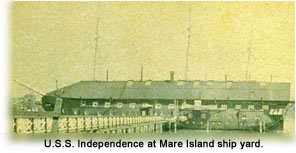|
FLAG LOWERED ON OLDEST FRIGATE
Historic Ship Independence is Placed
Out of Commission at Mare Island.
CALLED NAVAL ARGONAUT.
Movement on Foot to Preserve Relic as an Exhibit for 1915 Exposition.
Special Dispatch to the “Chronicle.”
 VALLEJO, November 19. —The historic old frigate Independence, for
the past fifty-four years receiving ship at Mare island and the oldest
ship in the United States Navy, was placed out of commission at Mare island
this morning. The ceremony of hauling down the flag was a simple one, and
the men and property were formally transferred to the more modern cruiser
Cleveland, lately returned from Nicaragua. VALLEJO, November 19. —The historic old frigate Independence, for
the past fifty-four years receiving ship at Mare island and the oldest
ship in the United States Navy, was placed out of commission at Mare island
this morning. The ceremony of hauling down the flag was a simple one, and
the men and property were formally transferred to the more modern cruiser
Cleveland, lately returned from Nicaragua.
Just what will be done with the Independence has not as yet been officially
announced. It has been frequently reported that the directors of the Panama-Pacific
Exposition would make some arrangements with the Government whereby the
relic of another century would become one of the exhibits in 1915. As yet
official word to this effect has never been received here.
Prominent Native Sons and Daughters of the Golden West have petitioned
the Government to retain the Independence because of its association with
the early history of California. For that reason it has often been referred
to as “the naval Argonaut,” it having first sailed up the coast
in 1846, before the days of gold.
The keel of the Independence was laid down at Boston in 1812, it having
been the intention of the Navy Department to have the ship ready for the
war with England in that year. However, unfortunate delays occurred and
the Independence was not launched until 1814, when as the flagship of Commodore
Bainbridge it took a prominent part in the war against Algiers.
In 1836, the frigate was still the pride of the old white navy, and
to keep it up-to-date it was cut down to three stacks, and the
guns reduced from seventy-four to fifty-four. At this time the
Independence was good for ten knots an hour in the wind, which was considered
very fast time.
In 1846, commanded by Commodore Shubrick, the Independence paid its
first visit to California, having come around the horn to harass the Mexican
coast, at the time of the war with that country. Returning to the east
coast, the frigate became the flagship of the European squadron. It returned
to this coast eight years later and has been at Mare island ever since.
The old frigate displaces 3700 tons, which is one-tenth of the
displacement of the new Pennsylvania. Its value at this time is in the
brass used in its make up. At that time, copper was a cheap metal, and
every bolt, rivet and rod on the Independence is of that mineral.
San
Francisco Chronicle
November 20, 1912
Return to the top of the page.
|